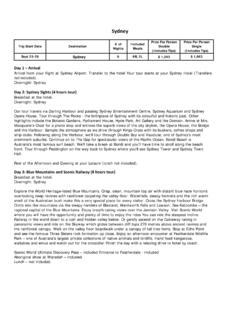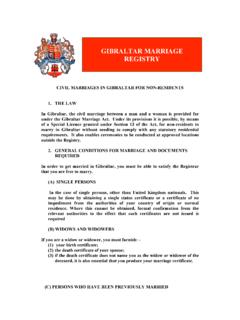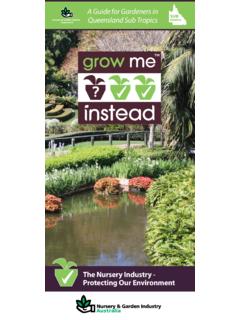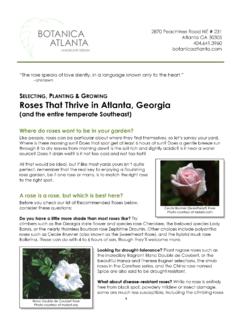Transcription of BRANTINGHAMTHORPE HALL - Yorkshire Gardens …
1 1 Yorkshire Gardens TRUST East Riding Historic Designed Landscapes BRANTINGHAMTHORPE hall Report by David and Susan Neave May 2013 1. CORE DATA Name of site: BRANTINGHAMTHORPE , hall Brantingham Grid reference: SE 945291 Administrative area: Brantingham Civil Parish, East Riding of Yorkshire Unitary Authority Current site designation: Not designated 2. SUMMARY OF HISTORIC INTEREST The parkland at BRANTINGHAMTHORPE is of interest as a good example of a modest planned landscape of the early 19th century, but of particular historical significance are the remnants of the Victorian formal Gardens laid out for visits of the Prince of Wales. 3. HISTORIC DEVELOPMENT OF THE SITE Estate owners The BRANTINGHAMTHORPE estate owned by Hugh Mason of Hull in the early 18th century passed through a number of owners until 1801 when it was purchased by Isaac Broadley (d. 1816), a Hull merchant, who was then living at Brantingham hall . Following Broadley s death it was sold in 1819 to Edward W.
2 Barnard, vicar of South Cave (d. 1828). Barnard s devisees sold the hall to Captain Richard Fleetwood Shawe (1804-72) in 1832. (Allison, Hull Gent, 49) The hall and estate were purchased in 1867 by the Revd Sir Henry Foulis on behalf of his nephew Sir Tatton Sykes 5th Bt. (ERALS, Deeds Registry KH/236/287.) It then became the home of Sir Tatton s brother, Christopher Sykes, who hosted a number of visits here by Edward, Prince of Wales, the first in July 1869. (Sykes, The Visitors Book , 84-87) From 1889 the house was tenanted by John Edward Wade, timber merchant, who bought the estate in July 1899 following the death of Christopher Sykes the 2 previous year. (Sewell, Joseph Armytage Wade, 24; Eastern Morning News 13 July 1899) Wade died on 28th September 1899. Later owners included George Thorpe-Wilson c. 1905-10, Sir John Sherburn, c. 1910-1929, Arnold Reckitt 1929-53, and Mrs Dorothy Maxted (daughter of Arnold Reckitt) who lived there 1953-73. Mrs Maxted was followed by her daughter Sally and her husband Christopher Frith.
3 The house was sold by the family in 1988 and has since changed hands a number of times. In 2013 BRANTINGHAMTHORPE hall was owned by John and Evonne Garton. Early history of the site The porch of the present Victorian house is said to be dated 1567. It is evidently on the site of, and may have at its core, the Elizabethan house built by Anthony Smethley who died in 1578. Nothing is known of its setting but in 1766 when BRANTINGHAMTHORPE hall was owned by Carleton Monkton it had modest grounds of around 8 acres (3 h.). (HHC, U DDCV/25/3 Brantingham Enclosure Plan, 1766.) It is likely that no extension to the grounds was undertaken until the hall was purchased by the Revd Edward Barnard in 1819. Chronological history of the designed landscape 1819-31 Edward Barnard In addition to the property acquired from Broadley s devisees, Barnard bought land adjoining the grounds of the hall from the Athorpe family and others. A diversion of the highway from Elloughton to Brantingham was obtained in 1819 which enabled the laying out of a small park.
4 (ERALS, HD/22) When the house was to let in 1824 it was said to have an excellent walled garden , lawn, shrubberies, fish pond and plantations . (York Herald 28 Feb. 1824) Barnard may have been responsible for much of this for Teesdale s plan of the East Riding, surveyed 1817-18, shows no obvious parkland, but the first edition Ordnance Survey 1 to the mile plan of 1824 does. The latter plan is not clear but parkland with boundary plantations are suggested. Bryant s plan of 1829 is clearer where the house is named as the Priory 1832 67 Richard Fleetwood Shawe Richard F. Shawe (1808-72) enlarged the house in the Gothick style and extended the parkland by moving the road from Elloughton to Brantingham further south-west in 1834. (ERALS, HD/39) He was probably responsible for planting some of the clumps and single trees shown in the parkland on the Ordnance Survey map published 1855. 3 Shawe was one of the original members of the Royal Agricultural Society and was evidently keen on horticulture.
5 (York Herald 18 Sept. 1872) The walled garden flourished under his head gardener, Robert Creaser Kingston (1818-95). Kingston was the son of the gardener at Saltmarshe hall and was working at Brantingham Thorpe by 1841. (Census Returns, 1841 HO 107/1216/15; Hull Packet 2 Sept. 1842) Kingston was a frequent prize winner and judge at the principal local horticultural shows and his son, Robert Creaser Kingston, jun. (1846-72) worked in the Royal Herbarium at Kew Gardens . (Hull Packet 2 Sept. 1842, 26 May 1843, 12 Sept. 1845, 16 July 1852 ; Journal of Botany, NS 1 (1872), 224) The Gardens were described in 1841: The whole cannot stand on less than four acres of land, which are laid out in a most judicious and elegant manner. There are four hot houses in the first kitchen- garden , in which are figs, nectarines, and vines against the wall whilst the floors are filled with early fruits of various kinds; the whole are heated by means of hot water conveyed through large iron pipes.
6 The dahlia or centre walk is very handsome, and the productions of the garden very fine. In the second kitchen garden is the forcing ground, asparagus beds, melon, and pine pits, the latter in every stage of growth to maturity. The shrubbery and flower garden , of more than two acres, is very beautiful. The rose walk from the first kitchen garden , the climbing roses creeping over a large frame work, and the aviary with its canary birds; goldfinches and turtle-doves are all very pretty, but the grand attraction is an elegant conservatory with many of the rarest and finest plants. (Allen, The Stranger s Guide, 67-9) 1867-89 Christopher Sykes On taking over the estate in 1867 Christopher Sykes largely rebuilt the house in time for the first royal visit in 1869 and made substantial changes to the grounds. It was stated in 1879 that BRANTINGHAMTHORPE as it is now is a very different place from what it was when Mr Sykes first bought it from Captain Shaw .. the park, the pleasure-grounds, the Gardens , the approach to the house.
7 Have been more or less transformed under Mr Sykes s judicious and indefatigable administration . (Beverley Guardian 13 Sept. 1879). A lodge was built on the Elloughton to Brantingham road (New Road) at the south-west corner of the park and a long drive led up to the hall . The changes to the Gardens were planned and supervised by James Craig Niven, curator of Hull Botanic Gardens 1853-81. He was seemingly responsible for the terrace to the south of the house, described in 1899 as being enclosed by stone retaining and parapet walls , and in two tiers, the upper one being neatly graveled with grass verges, and the lower one embracing a beautifully level lawn, interspersed with flower beds . 4 From the terrace the lawn extended to, and included, the tennis court, and thence it ascends by a flight of stone steps to the Eastern Lawn, which opens out expansively to the rear of the house, and towards the middle of which stands the Conservatory. The rear of the house is beautifully shrouded by ancient yews, and the lawn is well sheltered by beech and other timber trees.
8 (HHC, U DDCV/25/46) The walled kitchen Gardens were described in 1899 as large, well-stocked, and productive . The heated glasshouses included early and late peach houses, early and late vineries and a rose house. There were also adequate potting sheds, forcing houses, frames, and pits . (HHC, U DDCV/25/46) The tunnel marked on the 1891 plan (below) runs from the house under the Eastern Lawn to give access to the Stables and Coach House. Statues and other garden features were scattered throughout the grounds a French leadwork figure and a French sundial were featured in an article on BRANTINGHAMTHORPE in Country Life in 1905. This well-illustrated article barely mentions the park and Gardens . An avenue of Wellingtonias leading from the Eastern Lawn via a wicket gate was known as the Royal Walk because it was planted by the Prince and Princess of Wales and various members of the Royal Family. The walk led to a summer house named by the Duchess of Edinborough [sic] Melovoid or beautiful view.
9 (HHC, U DDCV/25/46) 20th Century The evidence from maps and images suggests that there were no major changes to the grounds in the 20th century, although the southern cormer of the park was cut into by the new route of the A63 and the lodge demolished. In 1987 it was noted that, the mature park trees and clumps have been recently enhanced by strategically sited tree planting schemes established with the aid of the Countryside Commission . (Humberside Property Guide, 29 May 1987) A grandson of Sir John Sherburn who visited BRANTINGHAMTHORPE hall around 2001 recorded that the glasshouses were in ruin and walled kitchen garden was full of weeds . (Wales, Reminiscences of the Rev. Vernon Clarke , 12) 4. SITE DESCRIPTION LOCATION BRANTINGHAMTHORPE hall and its park are located immediately south-east of Brantingham village, north of the A63, about 12 miles west of Hull and 2 miles north of Brough. AREA 5 Gardens , park and woodland about 75 acres ( ha), of this the open parkland 53 acres ( ha).
10 BOUNDARIES The park is bounded on the south-west by the A63 and the now disused section of the road from Brantingham to Elloughton (formerly New Road). The boundary to the south-east is the parish boundary with Elloughton and the Scarborough Wold Plantation, to the north the drive or lane from the hall to Brantingham village, and to the east the western boundary of fields on the Wolds slope. LANDFORM BRANTINGHAMTHORPE Park lies on the west facing slope of the Yorkshire Wolds. The land rises west to east from 30m to 80m AOD, rising most steeply to the east of the hall . The hall and Gardens lie at the bottom of the chalk slope. Chalk (Ferriby Chalk Formation) forms the bedrock of the hall site, Gardens and parkland to the north east, and a grey calcareous siltstone (Brantingham Member) the bedrock of the parkland to the south east. The surface deposit is alluvium throughout. SETTING The parkland is in East Riding Landscape Character Area 12 , Yorkshire Wolds Sloping Wooded Farmland.






